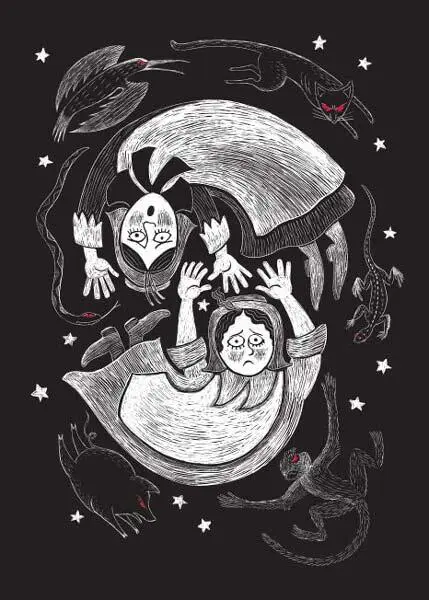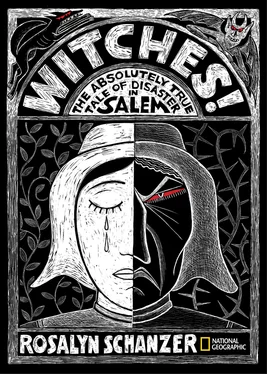Rosalyn Schanzer - Witches - The Absolutely True Tale of Disaster in Salem
Здесь есть возможность читать онлайн «Rosalyn Schanzer - Witches - The Absolutely True Tale of Disaster in Salem» — ознакомительный отрывок электронной книги совершенно бесплатно, а после прочтения отрывка купить полную версию. В некоторых случаях можно слушать аудио, скачать через торрент в формате fb2 и присутствует краткое содержание. Жанр: unrecognised, на английском языке. Описание произведения, (предисловие) а так же отзывы посетителей доступны на портале библиотеки ЛибКат.
- Название:Witches: The Absolutely True Tale of Disaster in Salem
- Автор:
- Жанр:
- Год:неизвестен
- ISBN:нет данных
- Рейтинг книги:3 / 5. Голосов: 1
-
Избранное:Добавить в избранное
- Отзывы:
-
Ваша оценка:
- 60
- 1
- 2
- 3
- 4
- 5
Witches: The Absolutely True Tale of Disaster in Salem: краткое содержание, описание и аннотация
Предлагаем к чтению аннотацию, описание, краткое содержание или предисловие (зависит от того, что написал сам автор книги «Witches: The Absolutely True Tale of Disaster in Salem»). Если вы не нашли необходимую информацию о книге — напишите в комментариях, мы постараемся отыскать её.
Witches: The Absolutely True Tale of Disaster in Salem — читать онлайн ознакомительный отрывок
Ниже представлен текст книги, разбитый по страницам. Система сохранения места последней прочитанной страницы, позволяет с удобством читать онлайн бесплатно книгу «Witches: The Absolutely True Tale of Disaster in Salem», без необходимости каждый раз заново искать на чём Вы остановились. Поставьте закладку, и сможете в любой момент перейти на страницу, на которой закончили чтение.
Интервал:
Закладка:
In addition, Parris owned two slaves—Tituba, an Arawak Indian woman who was kidnapped by a slave runner in South America when she was a young child, and her husband, John Indian, who had been married to Tituba for the past three years. Tituba had helped raise the Parris children ever since they were babies.
If all had been well during this unusually harsh winter, Betty and Abigail would have spent most of their time working together indoors. There was not much playtime in Salem Village; children were expected to help out the same as adults from the time they were about four or five years old. So when there were chores to do (and there were always chores to do—except on Sunday, when everyone was in church), the two girls might have knit some warm socks, boiled laundry in their enormous fireplace, swept ashes off the floors, ladled out porridge for breakfast, or helped make a wild venison pie and some sweet pudding for lunch in their big iron cooking pot. When all this work was done, they could card some wool or linen, twist its fibers into yarn on a wooden spindle, mend torn britches, or even upholster a chair. Of course, they would spend some time studying the Bible and saying their prayers. And if they ever took a break, they might sip some pear or apple cider from large pewter cups.
But that’s not what happened one freezing day in January 1692. Not at all. For as winter’s sleet and snow heaped higher and higher outside their door, Betty and Abigail began to twitch and choke and contort their bodies into strange abnormal shapes, crouch beneath the furniture, and speak in words that made no sense.

CHAPTER TWO
A DIRE DIAGNOSIS
Days passed, but the two girls’ frightening symptoms only intensified, even though no one else in the household was getting sick. So Reverend Parris began to wonder. Maybe the children’s illness meant that God was sending him a sign. Maybe his congregation had committed some unforgivable sin and was being punished for its own good!
And did the reverend see a second sign of God’s wrath? Just one week after the awful fits first struck, and a mere 75 miles to the north, in York, Maine, the Abenaki Indians and their French allies attacked, leaving the town in flames. Even babies, women, and farm animals had been slaughtered. Puritans like Reverend Parris had long believed that Indians were devils and their shamans were witches. He may have wondered if God had unleashed the destroyers to teach his subjects a lesson.
Perhaps Parris had received a third sign as well, for early in February a homeless woman named Sarah Good came knocking at Parris’s door, begging for food for her baby and her four-year-old daughter, Dorcas. As Sarah Good turned to go, she muttered something under her breath. Was their gift too small? Were her words curses, the kind that caused crops to fail and livestock to die? The two afflicted girls soon seemed to get much worse.
Parris thought some more and began to wonder if he himself had been the sinner. Had he been lax in his duties as a minister or as a father? Parris prayed and fasted, and so did the rest of his family. He consulted with doctors and tried dosing the girls with every elixir he could find, from parsnip seeds in wine to smelling salts made from blood, ashes, and deer antlers. Nothing worked.
Then an elderly physician named William Griggs, who had lived in Salem Village for perhaps two years, examined Betty and Abigail and declared that they were most certainly “under an Evil Hand.” This was the worst of all possible news because it meant that the two girls were BEWITCHED!
Dr. Griggs had good reason to think so.
As early as the 1640s, about 50 years before Betty and Abigail first got sick, settlers in New England had begun to suffer from violent, life-threatening fits. Even farm animals wrestled with these convulsions; many that seemed healthy one day could wind up dead the next. But why? Doctors couldn’t find any rational explanation for the victims’ bizarre contortions. Nor could they explain people’s visions of dark apparitions and bright lights; their temporary paralysis; their blindness and deafness; or their claims that they were being pinched, choked, bitten, scratched, sat upon, or pricked with pins.
Before long, the Puritans began to look for answers in the Invisible World. Was this truly some new dread disease, or could the symptoms have been caused by witches? After all, the Devil’s witches could infiltrate the Natural World. If such an invasion had occurred in New England, perhaps these dreadful creatures were working their magic on mere mortals, casting spells and stabbing images of victims from afar to inflict pain, or staring at their prey with a poisonous Evil Eye until they died. Worse yet, witches could be corrupting the innocent, who might join league with the Devil by signing his book of laws just to ease their pain—or bargain away their own immortal souls in exchange for their heart’s desire.
That’s why in 1641, 1642, and 1655, new laws in Massachusetts and Connecticut proclaimed that witchcraft was a crime punishable by death. The first so-called witch to hang was a healer from Charlestown, Massachusetts, named Margaret Jones. It was said that her mere touch could cause violent pains, deafness, and vomiting, and that she had used witchcraft to kill animals. She was tried and hanged in 1648 during an epidemic of fits. But most cases like hers were thrown out of court for lack of solid evidence or because magistrates and ministers thought the witnesses were delusional or carried a grudge against the accused. Take the case of a New Haven, Connecticut, widow named Elizabeth Godman. In 1655, she was released from jail in spite of one woman’s claims that Godman was pinching her and causing dreadful fits that left her boiling hot, freezing cold, and shrieking in pain.
The rash of mysterious fits never disappeared completely, and by the 1680s, rumors about this dread disease were scaring people half to death. Fear spread even farther when a popular father-and-son team of Boston ministers named Increase and Cotton Mather wrote several astonishing books and essays about settlers who were possessed by demons or plagued by witches. One of the most terrifying tales came from Cotton Mather’s 1689 best seller, Memorable Providences. Everyone flocked in droves to read this story, especially since Mather claimed that he had watched with his own two eyes as every detail unfolded.
In the reverend’s book, four children from a pious Boston family were suffering from horrible fits. Their tongues would first be sucked down their own throats, then pulled out upon their chins to a prodigious length. Their jaws would snap out of joint and then clap together like a strong spring lock. They cried that they were being cut with knives, then struck with blows. Their necks were broken! Their heads were twisted almost all the way around! And they would bark like dogs or roar exceedingly loud. These tortures were blamed upon a neighbor, an old Irish Catholic washerwoman named Goody Glover, who was suspected of being a witch. Before long, she was tried in court and hanged by the neck until dead. Surely Reverend Parris and Dr. Griggs knew all about this famous tale.
The day after Dr. Griggs presented his dire diagnosis to the Parris family, Reverend and Mrs. Parris rode off to a lecture. While they were there, they hoped to invite some neighboring ministers to join them in their home for a solemn day of prayer. But as soon as the parents left, the two Parris slaves, Tituba and John Indian, did something that was strictly forbidden. They knew that in New England, people used folk magic all the time to perform cures, even though Puritan ministers railed against it. There were ways to draw out witches—by boiling snippets of children’s hair, for example—and the two slaves were apparently so worried about Betty and Abigail that John Indian accepted a set of instructions from their helpful neighbor, Goodwife Mary Sibley, telling how to bake a black magic witchcake.
Читать дальшеИнтервал:
Закладка:
Похожие книги на «Witches: The Absolutely True Tale of Disaster in Salem»
Представляем Вашему вниманию похожие книги на «Witches: The Absolutely True Tale of Disaster in Salem» списком для выбора. Мы отобрали схожую по названию и смыслу литературу в надежде предоставить читателям больше вариантов отыскать новые, интересные, ещё непрочитанные произведения.
Обсуждение, отзывы о книге «Witches: The Absolutely True Tale of Disaster in Salem» и просто собственные мнения читателей. Оставьте ваши комментарии, напишите, что Вы думаете о произведении, его смысле или главных героях. Укажите что конкретно понравилось, а что нет, и почему Вы так считаете.












